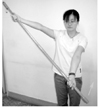Abstract
Adhesive capsulitis was described initially as periarthritis, and then frozen shoulder. Adhesive capsulitis of the shoulder is an insidious, painful condition that results in a gradual restriction of movements. Adhesive capsulitis can be classified into primary or secondary. Primary adhesive capsulitis is an insidious condition, whereas secondary adhesive capsulitis is associated with a known pathology. The pathogenesis remains unclear. Gross pathological changes include thickening and constriction of the capsule, especially anterioinferiorly with a very little amount of synovial fluid in the joint space. Many patients continue to have a significant long-term restriction in their range of motion, although few are functionally restricted. Classically adhesive capsulitis is divided into three phases : the painful phase, the stiff phase, and the resolution phase. The diagnosis of adhesive capsulitis is based on a thorough history taking and physical examination. Radiographs of the shoulder are usually negative. An arthrogram may show a decrease in the intraarticular volume and an absence of the axillary recess. The final confirmation of the diagnosis is made by an experience of relief of pain following an intra-articular anesthetic. Prevention is the ideal treatment. The goals of treatment are to relieve pain, to restore motion, and to restore function. Treatment modalities include anti-inflammatory medications, physical therapy including therapeutic exercise, corticosteroid injection, suprascapular nerve block, capsular distension, manipulation under anesthesia, and arthroscopic capsular release. It is necessary to refine the selection of treatment for individual patients according to the phase of the disease.
References
1. Neviaser JS. Adhesive capsulitis of the shoulder: a study of the pathologic findings in periarthritis of the shoulder. J Bone Joint Surg. 1945. 27:211–222.
2. Lundberg BJ. The frozen shoulder: clinical and radiographical observations:the effect of manipulation under general anesthesia: structure and glycosaminoglycan content of the joint capsule. Acta Orthop Scand. 1969. 119:1–59.
3. McLaughlin HL. On the "frozen" shoulder. Bull Hosp Joint Dis. 1951. 12:383–393.
4. Rodeo SA, Hannafin JA, Tom J, Warren RF, Wickiewicz TC. Immunolocalization of cytokines and their receptor in adhesive capsulitis of the shoulder. J Orthop Res. 1997. 15:427–436.

5. Binder AI, Bulgen DY, Hazelman BL, Robers S. Frozen shoulder: a long-term prospective study. Ann Rheum Dis. 1984. 43:361–364.

7. Hannafin JA, Chiaia TA. Adhesive capsulitis:a treatment approach. Clin Orthop. 2000. 372:95–109.
8. Reeves B. The natural history of the frozen shoulder syndrome. Scand J Rheumatol. 1975. 4:193–196.

10. Ryu KN, Lee SW, Rhee YG, Lim JH. Adhesive capsulitis of the shoulder joint: usefulness of dynamic sonography. J Ultrasound Med. 1993. 12:445–449.

11. Binder AI, Bugen DY, Hazleman BL, Tudor J. Frozen shoulder: an arthographic and radionuclear scan assessment. Ann Rheum Dis. 1984. 43:365–369.
13. Hollingworth GR, Ellis R, Haggersley TS. Comparison of injection techniques for frozen shoulder pain:results of a double-blind, randomized study. BMJ. 1983. 287:1339–1341.

14. Dacre JE, Beeney N, Scott DC. Injections and physiotherapy for the painful stiff shoulder. Ann Rheum Dis. 1989. 48:322–325.

15. Rizk TE, Christopher RP, Pinals RS. Treatment of adhesive capsulitis(frozen shoulder): a new approach to its management. Arch Phys Med Rehabil. 1983. 64:29–33.
16. Vad VB, Sakalkale D, Warren RF. The role of capsular distension in adhesive capsulitis. Arch Phys Med Rehabil. 2003. 84:1290–1292.
17. Rizk TE, Gavant ML, Pinals RS. Treatment of adhesive capsulitis(frozen shoulder) with arthrographic capsular distension and rupture. Arch Phys Med Rehabil. 1994. 75:803–807.

18. Gam AN, Schydlowsky P, Rossel I, Remvig L, Jensen EM. Treatment of "frozen shoulder" with distension and glucocorticoid compared with glucocorticoid alone. Scand J Rheumatol. 1998. 27:425–430.
20. Fareed DO, Gallivan WR Jr. Office management of frozen shoulder syndrome: Treatment with hydraulic distension under local anesthesia. Clin Orthop. 1989. 242:177–183.
22. Karatas GK, Meray J. Suprascapular nerve block for pain relief in adhesive capsulitis:comparison of 2 different techniques. Arch Phys Med Rehabil. 2002. 83:593–597.
24. Janda DH, Hawkins RJ. Shoulder manipulation in patients with adhesive capsulitis and diabetes mellitus:a clinical note. J shoulder Elbow Surg. 1993. 2:36–38.





 PDF
PDF ePub
ePub Citation
Citation Print
Print







 XML Download
XML Download